#functions of IoT gateway
Explore tagged Tumblr posts
Text
0 notes
Text
Live stream happened, and we got some designs revealed! As well as a couple of information, but not anything major.

Miss conductor, not much of a surprise (but miss girl looks gorgeous as always)

And Node, who is sort of the main antagonist.
I made a prediction before, and April 21 hit,.. so I believe it is well due for an update by now.
While we did not receive nearly as much information as we were anticipating, a design still reveals much on the character itself when going through the lens of a general analysis. In this context, their abilities and name aid significantly in the status and essential depths of their character.
With what I can gather in my research, nodes play an important role in networking because they are the building blocks of a network, precisely the gateway for connection, direction, sending, creating, receiving, and storing data. It requires only software to connect to the network, and it can be run by completely anyone. Applying this knowledge with concept arts of the game and overall worldbuilding of the series itself—everything becomes a lot clearer.
So now, how can we apply this to Node?

Node's name is simple in itself, and it connects to their design as well. They are quite literally made up of nodes. One in their head and the other in their limbs. Their body is translucent.
Network nodes are categorical. Thanks to DJ, we got a helpful hint that incredibly reduced their types to a digestible and simpler layout.
Their name starts with i.
There are countless forms and types of nodes, the hint condensed it down to 2 answers, both starting with the letter “i”
Intermediate nodes
These include devices like routers and switches that help direct data to the correct destination while also receiving it. They don't originate or terminate data but instead pass it along to where it needs to go.
IoT nodes
loT (Internet of Things) Nodes serve as devices that establish connectivity to the Internet via a gateway, effectively enabling the integration of the physical world into the vast realm of the Internet. Within an loT ecosystem, these nodes function as crucial components for bridging the gap between the physical and virtual worlds. Taking charge of managing the entire loT system.
We had seen this ability before vía King's icons' staff, in which it only sucked in Minecraft mobs due to the strong force being their obligatory origin, overriding the game itself due to the overlapping icons.
In regards to King, he used this ability for the very destruction of the game itself, down to the code, reducing it to nothing but.. nothing for the sake of vengeance. Or at least what would have occurred if he did succeed.
way to go CG! Give credit where it's due
Despite this being marked with the intention of erasion and minimization, I think it's safe to group this as receiving and storing data. The two icons combined created a horrifically dramatized version of the force with storing and receiving, which created an incredibly overpowered demolishing force.

In Chosen, we had seen this ability before as well, as the constellations are seen right as he creates the gateway from the Outernet, which sounds awfully familiar. This is what you would refer to as an "extension to the digital world"
I think I can be able to safely group this to direction and creation.


From how I see it, it seems as though it's quite diverse in a fictional worldbuilding sense within characters.
And obviously, it won't be the last time we would see it. It seems as though we would be exploring this quite a lot.


In their cameo, Node is in an assumed line-up with all the major series antagonists.

But if you’re asking me, it seems as though our iconic antagonists appear to be rather victims of Node. Menacingly behind them, their abilities floating not far behind as they're stuck in a swampy substance. But that's just me.
Node's entire antagonistic ordeal is beyond my grasp, but I'm assuming their abilities and attacks surrounds the embodiment of network topology, which would mold and diverse into the connections of nodes. They possibly intend to screw up with the gateways that are responsible for the receiving, directing, and sending of data between various devices through communication links that are defined as network—with the basic visuals of concept art we were given.

(The gateway, ethernet tunnels, the train cough cough)
Node's goal and story behind that destruction remains anonymous, as the writing is still in early development. Regardless, food for thought.
#alan becker#animation vs minecraft#animator vs animation#animation versus#nerd voyage#it's pretty interesting#though my research is still ongoing#when i say it's diverse..#yeah it's diverse alright
88 notes
·
View notes
Text
Navigating the Cloud: Unleashing Amazon Web Services' (AWS) Impact on Digital Transformation
In the ever-evolving realm of technology, cloud computing stands as a transformative force, offering unparalleled flexibility, scalability, and cost-effectiveness. At the forefront of this paradigm shift is Amazon Web Services (AWS), a comprehensive cloud computing platform provided by Amazon.com. For those eager to elevate their proficiency in AWS, specialized training initiatives like AWS Training in Pune offer invaluable insights into maximizing the potential of AWS services.

Exploring AWS: A Catalyst for Digital Transformation
As we traverse the dynamic landscape of cloud computing, AWS emerges as a pivotal player, empowering businesses, individuals, and organizations to fully embrace the capabilities of the cloud. Let's delve into the multifaceted ways in which AWS is reshaping the digital landscape and providing a robust foundation for innovation.
Decoding the Heart of AWS
AWS in a Nutshell: Amazon Web Services serves as a robust cloud computing platform, delivering a diverse range of scalable and cost-effective services. Tailored to meet the needs of individual users and large enterprises alike, AWS acts as a gateway, unlocking the potential of the cloud for various applications.
Core Function of AWS: At its essence, AWS is designed to offer on-demand computing resources over the internet. This revolutionary approach eliminates the need for substantial upfront investments in hardware and infrastructure, providing users with seamless access to a myriad of services.
AWS Toolkit: Key Services Redefined
Empowering Scalable Computing: Through Elastic Compute Cloud (EC2) instances, AWS furnishes virtual servers, enabling users to dynamically scale computing resources based on demand. This adaptability is paramount for handling fluctuating workloads without the constraints of physical hardware.
Versatile Storage Solutions: AWS presents a spectrum of storage options, such as Amazon Simple Storage Service (S3) for object storage, Amazon Elastic Block Store (EBS) for block storage, and Amazon Glacier for long-term archival. These services deliver robust and scalable solutions to address diverse data storage needs.
Streamlining Database Services: Managed database services like Amazon Relational Database Service (RDS) and Amazon DynamoDB (NoSQL database) streamline efficient data storage and retrieval. AWS simplifies the intricacies of database management, ensuring both reliability and performance.
AI and Machine Learning Prowess: AWS empowers users with machine learning services, exemplified by Amazon SageMaker. This facilitates the seamless development, training, and deployment of machine learning models, opening new avenues for businesses integrating artificial intelligence into their applications. To master AWS intricacies, individuals can leverage the Best AWS Online Training for comprehensive insights.
In-Depth Analytics: Amazon Redshift and Amazon Athena play pivotal roles in analyzing vast datasets and extracting valuable insights. These services empower businesses to make informed, data-driven decisions, fostering innovation and sustainable growth.
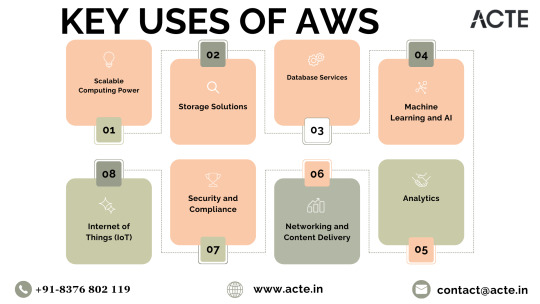
Networking and Content Delivery Excellence: AWS services, such as Amazon Virtual Private Cloud (VPC) for network isolation and Amazon CloudFront for content delivery, ensure low-latency access to resources. These features enhance the overall user experience in the digital realm.
Commitment to Security and Compliance: With an unwavering emphasis on security, AWS provides a comprehensive suite of services and features to fortify the protection of applications and data. Furthermore, AWS aligns with various industry standards and certifications, instilling confidence in users regarding data protection.
Championing the Internet of Things (IoT): AWS IoT services empower users to seamlessly connect and manage IoT devices, collect and analyze data, and implement IoT applications. This aligns seamlessly with the burgeoning trend of interconnected devices and the escalating importance of IoT across various industries.
Closing Thoughts: AWS, the Catalyst for Transformation
In conclusion, Amazon Web Services stands as a pioneering force, reshaping how businesses and individuals harness the power of the cloud. By providing a dynamic, scalable, and cost-effective infrastructure, AWS empowers users to redirect their focus towards innovation, unburdened by the complexities of managing hardware and infrastructure. As technology advances, AWS remains a stalwart, propelling diverse industries into a future brimming with endless possibilities. The journey into the cloud with AWS signifies more than just migration; it's a profound transformation, unlocking novel potentials and propelling organizations toward an era of perpetual innovation.
2 notes
·
View notes
Text
Final Year Projects, PHP Projects, and IEEE Projects: Your Complete Guide to Academic Success
Choosing the right Final Year Projects is a pivotal step in every engineering or computer science student’s academic journey. Whether you’re building robust PHP Projects or diving into innovative IEEE Projects, selecting the right topic and technology can shape your career path and academic standing.
At ClickMyProject.com, we provide expert-curated, real-time projects tailored for final-year students across various domains, helping you stand out in your academics and beyond.
Why Final Year Projects Matter More Than You Think
Final Year Projects are not just academic requirements; they’re a demonstration of your practical skills, problem-solving capabilities, and technical understanding. They reflect your ability to apply classroom knowledge in real-world scenarios.
Benefits of a Great Final Year Project:
Enhances your resume and portfolio
Increases chances of placement in top companies
Serves as a strong foundation for higher studies
Offers hands-on experience with real-time technologies
Whether you're into machine learning, web development, or IoT, a well-structured Final Year Project can open doors you didn’t even know existed.
PHP Projects: Build Practical Web Applications with Ease
PHP Projects are popular among final-year computer science students for their simplicity, scalability, and widespread industry relevance. PHP (Hypertext Preprocessor) is a freely available, open-source scripting language that enables developers to build interactive and dynamic web applications that function seamlessly across different platforms.
ClickMyProject.com features a diverse library of 500+ PHP Projects across multiple domains, providing practical solutions for students and developers alike.
E-commerce and Online Shopping Platforms
School and College Management Systems
Hospital, Library, and Banking Systems
Why Choose PHP for Your Final Year Project?
Easy to learn and implement
Works seamlessly with MySQL databases
Ideal for both front-end and back-end development
Cost-effective and well-documented online
IEEE Projects: Innovation That Aligns With Industry Standards
IEEE Projects are based on the latest research and technologies recommended by the Institute of Electrical and Electronics Engineers (IEEE). These projects are ideal for students aiming to work in R&D, secure government jobs, or pursue higher education abroad.
ClickMyProject.com offers an extensive selection of IEEE Projects across cutting-edge fields such as:
Artificial Intelligence
Cybersecurity
Blockchain
Renewable Energy Systems
Cloud Computing and Big Data
Each IEEE Project comes with complete documentation, source code, and implementation guidance, making your final-year journey smooth and successful.
FAQs – IEEE Projects
1: Are IEEE Projects more complex than regular projects? They typically involve advanced concepts but come with structured guidance to help you succeed.
2: Can I publish a paper based on my IEEE Project? Yes, most IEEE Projects are designed with publication potential and align with journal requirements.
3: Do IEEE Projects have better industry recognition? Absolutely. Employers and universities value IEEE Projects for their innovation and relevance.
4: Are PHP Projects suitable for non-programmers?Yes, PHP is known for its simple syntax and ease of use, which makes it an ideal choice for beginners starting their coding journey.
5: Can I integrate APIs into my PHP Projects? Absolutely. PHP supports API integrations like payment gateways, SMS, and email services.
6: Are PHP Projects scalable for real-world applications? Yes, many enterprise-level applications and startups use PHP to this day, thanks to its flexibility.
Why Choose ClickMyProject.com?
With over a decade of experience delivering high-quality academic project solutions, ClickMyProject.com has helped thousands of students succeed. Whether you're working on your Final Year Projects, exploring hands-on PHP Projects, or tackling advanced IEEE Projects, we offer:
Ready-to-deploy project kits
Customization support
Project explanations via Zoom/Meet
Complete documentation and source code
Conclusion: Start Your Final Year Project with Confidence
Whether you're building PHP Projects for practical exposure or choosing cutting-edge IEEE Projects for research excellence, your Final Year Projects represent the culmination of your academic efforts. Make it count with ClickMyProject.com—your trusted partner for smart, scalable, and impactful academic projects.
0 notes
Text
[IOTE 2025 Shenzhen Exhibitor] China's AI Vision Vanguard: 5 Innovators Transforming Perception | IOTE 2025 #23
AGIC + IOTE 2025, the 24th International Internet of Things Exhibition — Shenzhen Station, will take place from August 27 to 29, 2025, at the Shenzhen World Exhibition & Convention Center. IOTE 2025 is set to be an unprecedented professional exhibition event in the field of AI and IoT. The exhibition scale will expand to 80,000 square meters, focusing on the cutting-edge progress and practical applications of “AI + IoT” technology. It will also feature in-depth discussions on how these technologies will reshape our future world. It is expected that over 1,000 industry pioneers will participate to showcase their innovative achievements in areas such as smart city construction, Industry 4.0, smart home life, smart logistics systems, smart devices, and digital ecosystem solutionsMany high-quality companies will appear in this exhibition as exhibitors. We welcome all industry friends to visit, learn and communicate, and participate in the industry event.
Shenzhen Jietong Technology Co., Ltd
Hangzhou Century Co., Ltd.
INTELLINDUST INFORMATION TECHNOLOGY (SHENZHEN) CO., LTD
Shenzhen Sharevdi Technology Co.,Ltd
RYOYO ELECTRO HONG KONG LIMITED
NO.1 Exhibitor Introduction

Shenzhen Jietong Technology Co., Ltd
Booth No.: 9B9
August 27–29, 2025
Shenzhen World Exhibition & Convention Center (Bao’an)
Company Profile
Shenzhen Jietong Technology Co., Ltd., founded in 2011, is a National High-Tech Enterprise and “Specialized, Refined, Differentiated, and Innovative (SRDI)” certified company. Jietong focuses on RFID (Radio Frequency Identification) technology development and applications, offering full-spectrum IoT solutions covering LF, HF, UHF, and 2.4GHz.
The company independently develops a wide range of RFID hardware including RFID modules, readers, smart gateways, and industrial terminals, while also providing custom electronic tag production and algorithm optimization services. With over a decade of experience, Jietong delivers turnkey data acquisition solutions for 20+ industries such as smart logistics, asset management, intelligent transportation, warehousing, apparel management, smart livestock farming, energy, retail anti-counterfeiting, and more.
Jietong is widely recognized and trusted by clients both domestically and internationally for its professional pre-sale, in-sale, and after-sale services, commitment to innovation, and active market expansion at home and abroad.
Product Recommendation
UHF 8-Channel RFID Reader — JT-7208 A high-performance ultra-high frequency RFID reader compliant with China’s military standards, supporting ISO18000–6C (EPC C1 GEN2) and GJB 7377.1–2011. Key features:
Multi-tag reading
Long reading distance
Robust industrial-grade protection
RJ45, RS485, RS232, 4G, and WiFi communication
Aluminum alloy casing with waterproof, dustproof, anti-interference, and lightning protection design
Ideal for harsh outdoor environments
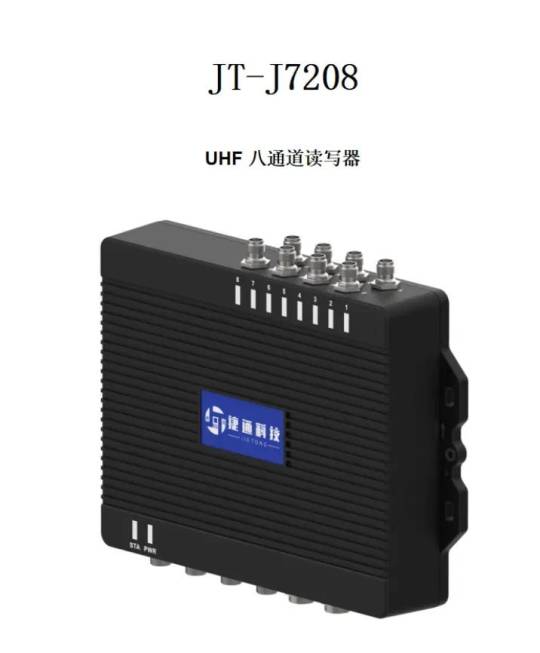
2.4G Active Sound & Light Tag — JT-T2482 This tag supports 2.4GHz communication and includes sound and light response functions, enabling remote interaction and alerts. Key features:
Low-power design
Custom command support
Full proprietary IP rights
Enhanced for smart tracking and identification scenarios
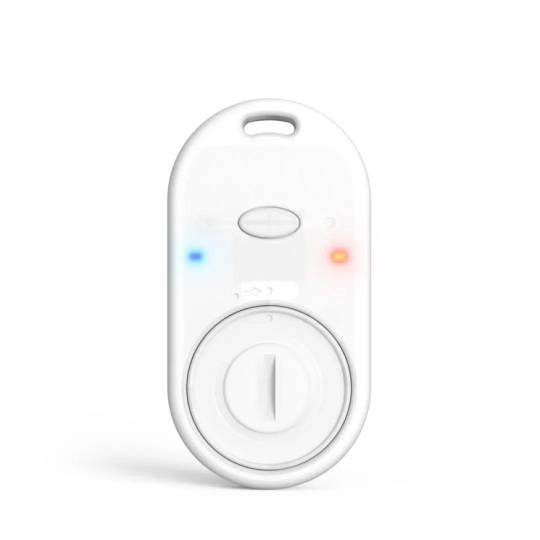
Industrial UHF RFID Reader — JT-7100 Engineered for industrial automation lines, this reader offers rugged durability with an IP66 rating and compact size for easy integration. Highlights:
Custom RF chip and advanced tag recognition algorithm
Supports MODBUS, PROFINET, CAN protocols
24/7 continuous operation without crashes
Designed with bottom magnetic plate for fast deployment
Lightweight and industrial-ready
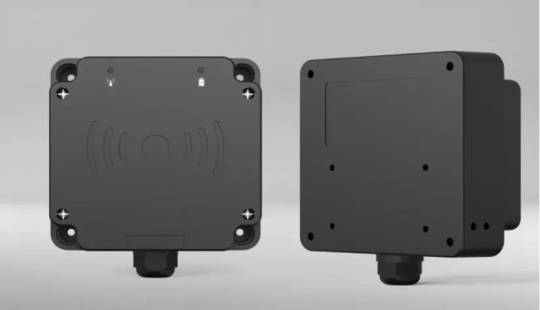
Shenzhen Jietong continues to drive the evolution of RFID and IoT applications with robust hardware and tailored solutions. Don’t miss their live demo at Booth 9B9 at IOTE 2025!
NO.2 Exhibitor Introduction

Hangzhou Century Co., Ltd.
Booth No.: 9C16
August 27–29, 2025
Shenzhen World Exhibition & Convention Center (Bao’an)
Company Profile
Hangzhou Century Co., Ltd. is a leading manufacturer and solution provider specializing in the design and production of EAS labels, RFID inlays, specialty tags, readers, and application software. Focused on becoming a key data entry point in the intelligent digital ecosystem, SML delivers diversified and customized IoT terminal products.
The company provides end-to-end smart solutions for smart retail, intelligent manufacturing, smart warehousing, and smart healthcare, empowering global customers to achieve digital transformation and intelligent upgrades.
Product Recommendation
RFID Apparel Tags SML offers a wide range of in-house designed RFID inlays in multiple categories and sizes, tailored for both general-purpose and customized garment applications.
Enhanced tag sensitivity and reliability in challenging retail environments
Anti-counterfeiting, traceability, and real-time product tracking
Ultra-thin, ultra-flexible fabric tags — 50% thinner than standard labels, ideal for high-end garment lifecycle management
Dual-frequency hard tags integrating RFID and EAS for enhanced visibility and theft prevention at retail stores
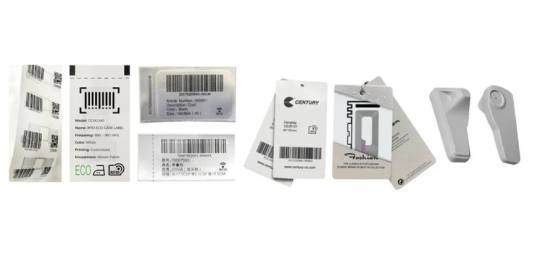
RFID Blood Labels SML’s RFID blood labels are engineered to meet stringent healthcare standards with outstanding performance in complex environments:
Custom antenna designs for both test tubes and blood bags
Strong adhesion at extreme temperatures (from ultra-low to ambient)
Resilient against high-speed centrifugation, X-ray, and gamma radiation
Embedded encryption and data-matching technology prevent mislabeling, ensuring full-process traceability in blood collection and supply chains

RFID Logistics Tags Optimized for performance in metal and liquid-rich environments, SML’s logistics RFID solutions feature:
Specially designed inlays to improve read sensitivity and anti-interference capabilities
Smart signal optimization and anti-collision algorithms to reduce missed reads in stacked or fast-moving logistics items
Seamless integration with handheld and gate readers for real-time inventory management, fast inbound/outbound processing, smart shelving, and efficient dispatching
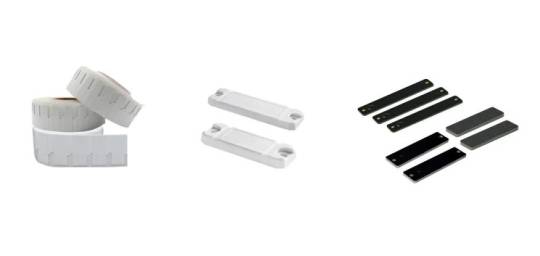
With advanced design, robust engineering, and a strong focus on digital innovation, Hangzhou Century Co., Ltd. is building the foundation of a smarter, more connected world. Explore their cutting-edge RFID solutions at Booth 9C16!
NO.3 Exhibitor Introduction

INTELLINDUST INFORMATION TECHNOLOGY (SHENZHEN) CO., LTD
Booth No.: 12A56
August 27–29, 2025
Shenzhen World Exhibition & Convention Center (Bao’an New Hall)
Company Profile
INTELLINDUST is a national high-tech enterprise and a specialized, sophisticated SME focused on AI visual computing and chip design. Headquartered in Shenzhen, it also operates subsidiaries in Beijing and Hefei. The company boasts a team of top-tier talent from prestigious institutions such as Tsinghua University, USTC, Zhejiang University, Wuhan University, the University of Tokyo, and École des Ponts ParisTech.
With strong R&D capabilities, Intellinda is dedicated to edge AI vision innovation, integrating optics, image processing, visual models (large and small), edge computing, chip design, embedded systems, and application software. The company is committed to solving the two major challenges in visual AI — “seeing clearly” and “understanding accurately.” It provides comprehensive cloud-edge-end solutions centered on visual AI algorithms, positioning itself as a one-stop provider in the visual AIoT sector.
INTELLINDUST ‘s solutions are widely applied in security, transportation, emergency response, firefighting, energy, and UAV industries, enabling smart upgrades and delivering significant business value to its clients.
Product Recommendation
1. Edge AI Computing Series
Universal edge AI appliances
Edge computing hubs
Large model AI all-in-one systems
AI smoke & flame detection cameras
Multimodal sensing modules
2. Software Platforms
AI video management platform
Automated AI model training platform
3. Intelligent Imaging Series
Ultra-low-light full-color surveillance PTZ cameras
Full-color night vision high-speed dome cameras
Full-color night vision turret and bullet cameras
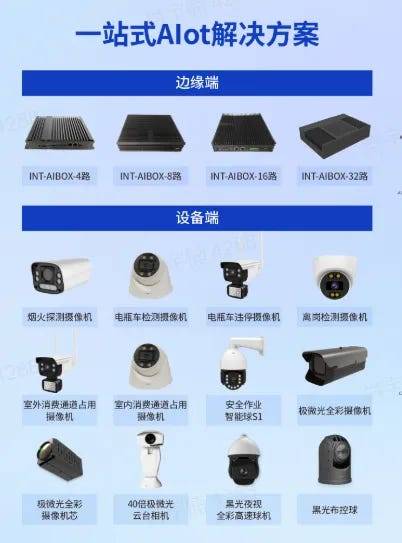
Highlight Product: AI Edge Intelligent Analysis Appliance
A domestically developed industrial-grade device designed to upgrade ordinary network cameras with AI capabilities. Equipped with high-performance NPU chips (up to 400+ TOPS INT8) and an embedded Ubuntu Linux OS, the appliance integrates video decoding, intelligent algorithms, and data transmission.
Key Advantages:
Multiple specs for different computing needs: Models available: INT-AIBOX-SG-32, SG-16, SG-8 with 32/17.6/10.6 TOPS (INT8).
Rich algorithm support for diverse use cases: Includes detection of fire, smoke, phone use, mask-wearing, PPE compliance, people counting, intrusion, improper parking, etc. Applicable to smart communities, industrial parks, campuses, refueling stations, hazardous materials management, and more.
Other features:
Supports up to 3 algorithms per camera
Intelligent patrol mode
High throughput & energy efficiency
Tailored for smart environments with high ROI

Ultra Low-Light Full-Color Camera — “YeYing” Series
The YeYing series leverages a self-developed AI Pre-ISP module, enabling full-color imaging at ultra-low light levels (as low as 0.0005Lux) without the need for external lighting. Ideal for scenarios such as night-time surveillance, border monitoring, ports, and UAV operations.
Advantages:
True full-color video in complete darkness
No light pollution
High frame rates, low latency
Passive design with customizable modules or camera systems
Form Factors:
Portable Smart PTZ: Quick deployment, perfect for emergency response
High-Speed Dome: Wide-area surveillance, fast tracking
Turret & Bullet Models: Flexible for various monitoring angles
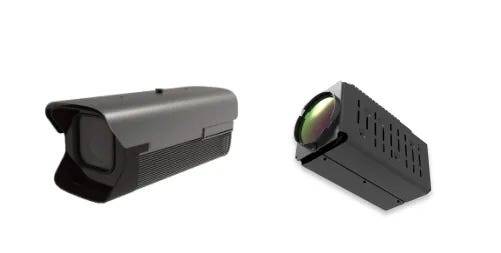
AI Smoke & Flame Detection Camera
This camera features patented AI algorithms to detect smoke and fire under infrared and visible light. It offers:
Early-stage detection: Detects smoldering and ignition phases
High accuracy, low false alarm rate
Long detection distance (up to 65 meters with 6mm lens)
Adaptability to various smoke and flame types
Applications: Fire prevention in urban communities, factories, shopping malls, forests, EV charging stations, and more.

AI Video Monitoring & Training Platforms
Automated AI Model Training Platform
Streamlines AI development with full automation — from data annotation and training to deployment — lowering barriers to entry and accelerating implementation for industry-specific AI applications.
AI Video Management Platform
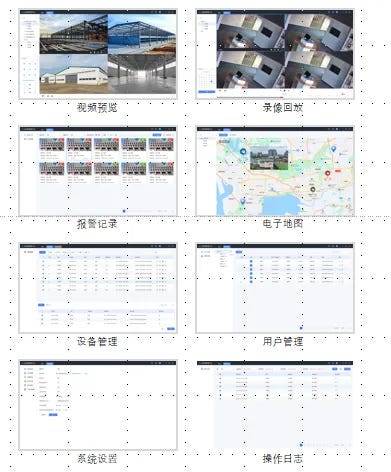
Multimodal Sensing Module
A core module integrating visual, audio, and environmental sensors. Applications include:
Smart air conditioners/fans: Auto on/off, wind direction/speed based on human presence
Smart restaurant checkout: Face and dish recognition for automated billing
Smart doors: Adaptive response based on user movement (wheelchair, groups), reducing mis-triggers and enhancing energy efficiency
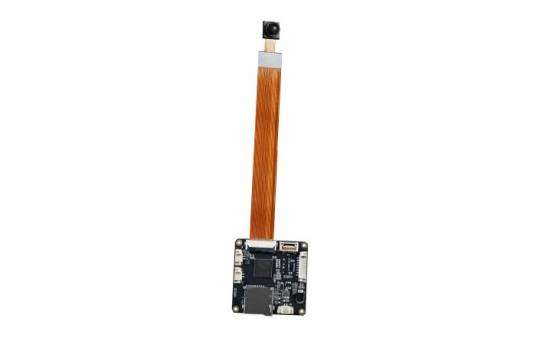
Join Us as a City Partner
Tired of:
Price wars
Manufacturer constraints
Transformation anxiety?
Intellinda offers:
Exclusive regional authorization
High-performance AI-powered hardware
Service-oriented, sustainable business model
Full-cycle support including training, market expansion, and innovation enablement
Step into the AI-powered future with Intellinda.
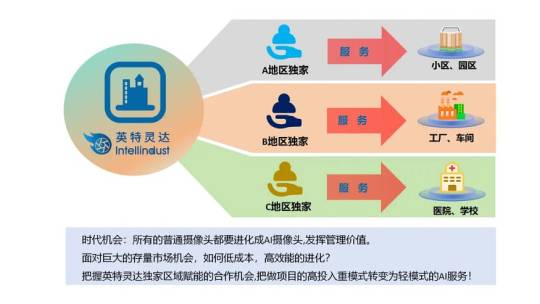
NO.4 Exhibitor Introduction
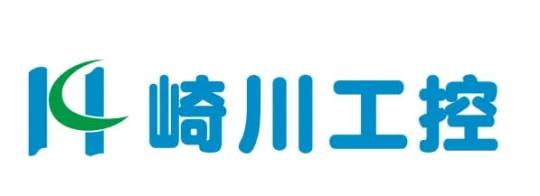
Shenzhen Sharevdi Technology Co.,Ltd
Booth No.: 12C95
August 27–29, 2025
Shenzhen World Exhibition & Convention Center (Bao’an)
Company Profile
Qichuan Industrial Control, a subsidiary of Shenzhen Sharevdi Technology Co.,Ltd., is a high-tech enterprise specializing in IoT edge terminal solutions. The company integrates R&D, design, manufacturing, sales, and service to provide high-quality products such as edge computing terminals, Xinchuang terminals, medical terminals, industrial computing terminals, and all-in-one industrial PCs. These solutions are widely used in smart security, smart cities, industrial automation, AI robotics, and intelligent manufacturing.
With the philosophy of “Focus, Innovation, Service,” Qichuan Industrial Control consistently improves product quality and service standards, earning a strong reputation and customer trust in the industry.
Product Recommendation
🔹 Qichuan AI Edge Computer G6-RK3588
High AI performance: 6TOPS AI computing power, expandable with a 26T AI acceleration stick; supports local execution of intelligent algorithms like facial recognition and security monitoring.
Full edge computing capabilities: Local data acquisition, processing, and decision-making improve responsiveness while reducing latency and bandwidth.
Comprehensive I/O options: Dual Gigabit Ethernet, RS232, USB, HDMI, and more. Compatible with various smart devices such as meters, sensors, and controllers.
Expandable storage: Built-in 128GB eMMC with SSD expansion support for long-term local data storage.
Excellent connectivity: Dual-band WiFi, Bluetooth 5.0+, optional 4G/5G, and dual Gigabit ports for seamless data transmission.
Industrial-grade reliability: Operates in -20°C to 60°C, built for harsh industrial environments.
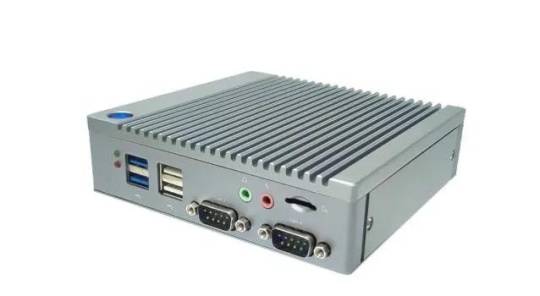
Qichuan AI Edge Computer G7-RK3576
Powerful AI engine: Built-in 6TOPS NPU with optional 26T AI stick; ideal for face recognition and defect detection.
Advanced graphics: Mali-G52 GPU enables 4K@120Hz rendering and offloads CPU load through heterogenous computing.
Rugged design: Operates reliably from -20°C to 60°C, suitable for outdoor or vehicle-based systems.
Extensive I/O: RS485, RS232, Wiegand interface, dual Gigabit LAN, PCIe NVMe (M.2), USB 3.0×3; supports high-speed machine vision data.
Multi-display support: HDMI-in + DP + HDMI-out for scenarios such as digital cockpits, AI avatars, and commercial displays.

Qichuan AI Edge All-in-One Industrial PC A14-RK3576
Robust computing power: Combines quad-core Cortex-A72 & A53 at 2.2GHz for high-load tasks in industrial control and security.
AI-optimized: Embedded 6TOPS NPU supports dual-mode or independent AI operations for facial and object recognition.
Versatile connectivity: Dual Gigabit LAN, USB 3.0, RS232 for broad peripheral compatibility (cameras, sensors, etc.).
Wide temperature resilience: Industrial-grade design operates from -20°C to 60°C, adaptable to challenging environments such as hot workshops or cold storage warehouses.
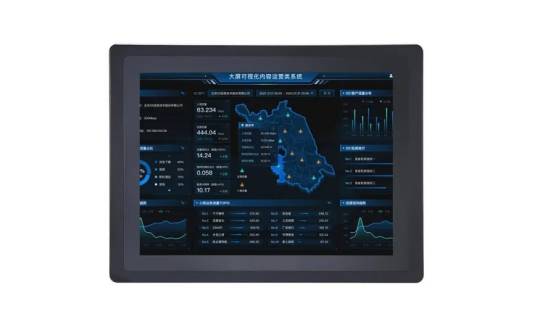
NO.5 Exhibitor Introduction

RYOYO ELECTRO HONG KONG LIMITED
Booth No.: 10C83
Date: August 27–29, 2025
Venue: Shenzhen World Exhibition & Convention Center (Bao’an)
Company Profile
Founded in 2003, RYOYO ELECTRO HONG KONG LIMITED. is a global trading and technical service company specializing in semiconductors, electronic products, and software. The company offers a wide range of products including advanced microbatteries, solar-powered beacons, IoT devices, TV SoCs, Bluetooth MCUs, LCD modules, fingerprint chips, TDDI, industrial dehumidifiers, and industrial CIS cameras.
These products are widely applied across IoT, security, computers and peripherals, mobile communications, automotive electronics, smart wearables, and industrial control systems. Backed by a professional sales and technical team, Ryoyo provides comprehensive and customized solutions for global clients.
Product Recommendation
Advanced Solid-State Microbattery
Product Highlights:
SMD packaging; sizes: 3.2×4.5mm, 8×9mm
Capacity: 100–500μAh, 1.5mAh
Operating Voltage: 2.25V / 3V
Charging Voltage: 2.7V
Solid-state design ensures high safety
Ultra-compact for space-saving designs
Rechargeable & eco-friendly
Certified by RoHS and EU standards
Applications: Ideal for wireless communication, medical devices, storage, networking equipment, wearable electronics, and IoT applications.
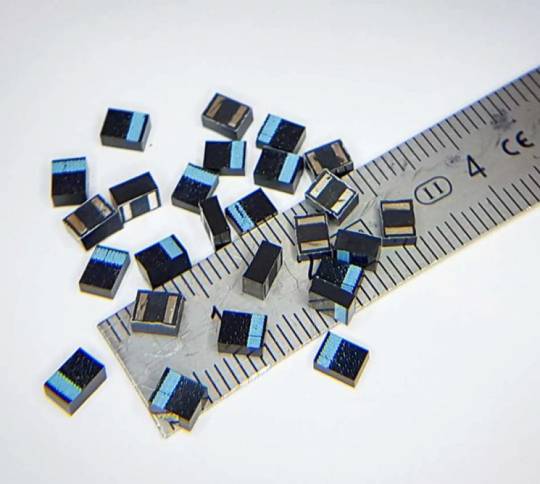
Bluetooth Solution: FR801X Series Low-Power BLE SoC
Key Specs:
Bluetooth 5.1 certified
Embedded 48KB SRAM
Integrated 2MB / 4MB Flash
Built-in PMU with up to 200mA charging current
150KB ROM for BLE Profile & GATT, LM, LC
16-bit Audio Codec (DAC SNR 96dB, ADC SNR 84dB)
Minimal external components, low BOM cost
Tools available: Windows serial configuration & Android OTA upgrade
Applications: Smart home, smart toys, electronic tags, remote controls.
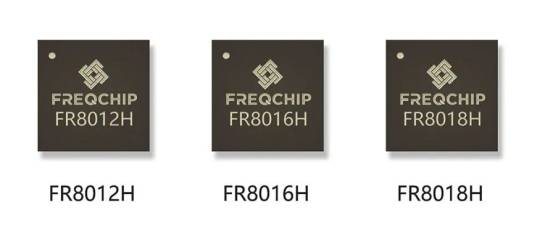
Display Driver / Fingerprint Recognition / Touch Control Solutions
These comprehensive solutions cover a variety of interface technologies, designed for next-generation electronics with high precision, seamless interaction, and enhanced user experience.




We sincerely invite you to participate in IOTE 2025, the 24th International Internet of Things Exhibition, Shenzhen Station, held at the Shenzhen World Convention and Exhibition Center (Bao’an New Hall) from August 27 to 29, 2025. At that time, you are welcome to discuss the cutting-edge trends and development directions of the industry with us, explore cooperation opportunities, and look forward to your visit!
0 notes
Text
Dubai’s Custom App Developers: Innovation at Its Best
In the digital age, Dubai stands tall as one of the world’s most forward-thinking cities. From smart government services to groundbreaking startups, innovation flows through every corner of this vibrant hub. One area that truly shows this spirit is the rise of custom mobile app development. Local businesses are no longer settling for off-the-shelf solutions — they’re choosing Dubai’s custom app developers to craft unique, high-performance apps that reflect their brand and keep their customers engaged.
So, what makes custom app developers in Dubai different? Why do businesses across industries trust them to deliver excellence? And how can you choose the best partner for your own project? This guide has everything you need to know.
Why Custom Apps Matter for Dubai’s Modern Businesses
In a city that never stops moving, customers expect brands to deliver seamless digital experiences. An average, generic app rarely makes an impact anymore. That’s where custom mobile apps in Dubai come in.
Unlike template-based apps, a custom app is built around your unique needs. Every screen, feature, and function is designed to match your goals, branding, and audience. For Dubai’s diverse market, this personalized touch makes all the difference.
Think about a retailer who wants a loyalty program built right into their app. Or a logistics company that needs real-time tracking and custom dashboards for drivers. Off-the-shelf solutions can’t do this well — but Dubai’s best developers can.
What Makes Dubai’s Custom App Developers Stand Out
Dubai’s app development community is known for its creativity, cultural understanding, and use of advanced technology. Here’s what sets them apart:
Deep Local Knowledge
Developers based in Dubai know what the local audience wants. They design apps that work for Dubai’s multicultural user base — whether that means supporting multiple languages, ensuring high security, or complying with UAE laws.
Innovation First
A leading mobile app development company in Dubai doesn’t just follow trends — they shape them. From AI features to AR shopping experiences, Dubai’s developers build apps that feel futuristic yet practical.
Quality and Performance
Dubai businesses can’t afford slow or glitchy apps. Local experts prioritize performance, ensuring apps run smoothly on every device and OS.
Scalability
Good developers in Dubai build apps ready to grow. Whether you’re a startup or an enterprise, your app can expand as your business does.
Clear Communication
Dubai’s top development teams keep clients updated at every stage — from the first wireframe to the final test.
Industries Driving Demand for Custom Apps in Dubai
From high-rise offices to bustling souks, Dubai’s industries are embracing custom mobile apps to stand out. Here are some of the leaders:
Retail and E-commerce
Dubai’s shopping culture demands next-level digital experiences. Brands use custom apps for personalized promotions, easy payments, and fast delivery tracking.
Hospitality and Tourism
Hotels, resorts, and tour operators use custom-built apps for bookings, room upgrades, loyalty perks, and local guides.
Real Estate
Property agencies rely on custom apps for virtual tours, client communication, and secure document sharing.
Finance and Banking
Fintech firms and banks offer secure, easy-to-use apps for payments, investments, and account management.
Logistics
Smart fleet tracking, delivery updates, and driver management tools are reshaping how Dubai’s logistics sector operates.
Choosing the Right Mobile App Development Company in Dubai
Picking the right partner is the first step toward success. Here’s what to look for:
Strong Portfolio
Review past projects. A reliable mobile app development company in Dubai will have proven work across industries.
Technical Expertise
Your app might need special features like payment gateways, IoT integrations, or AI chatbots. Make sure your partner can deliver.
Client-Centric Approach
Good developers listen. They want to understand your business before writing a single line of code.
Support and Maintenance
A great app needs updates and fixes. Choose a company that offers post-launch support.
Clear Costs
Ask for detailed estimates upfront — no hidden charges later.
The App Development Process: What to Expect
Wondering how Dubai’s custom developers bring an idea to life? Here’s a look:
Discovery
The team learns about your goals, audience, and must-have features.
Design
Wireframes, mockups, and user flows are crafted to ensure a great user experience.
Development
Developers build the app using secure, clean code and the best tech stack for your project.
Testing
Your app is tested on different devices and platforms to catch any bugs.
Launch
The app goes live on app stores, ready for users.
Post-Launch
Good developers monitor performance, fix issues, and roll out updates.
Five Programmers: Bringing Dubai’s App Ideas to Life
If you’re serious about building an app that truly represents your brand, Five Programmers is here to help. As a trusted mobile app development company in Dubai, Five Programmers has helped businesses in retail, real estate, and other sectors launch powerful custom apps that deliver results.
From first concept to final launch, their team brings creativity, technical skill, and genuine dedication to every project.
FAQs: Dubai’s Custom App Development
How much does a custom app cost in Dubai? Costs vary based on features and design complexity. Basic apps can start around AED 30,000, but complex solutions will cost more.
How long does it take to build a custom app? Depending on your requirements, expect 3–6 months on average.
Is my app idea safe with a Dubai developer? Reputable companies sign NDAs and follow strict confidentiality practices.
Will my app support multiple languages? Yes! Dubai’s audience is diverse, so apps often include English, Arabic, and other languages.
Ready to Build Your App? Let’s Talk
Dubai’s thriving digital economy rewards those who think ahead. A custom app designed by top developers can help you connect with customers, build loyalty, and stay ahead of the competition.
Don’t wait to bring your vision to life. Contact us today or Get a Quote from Dubai’s trusted custom app experts. Your big idea deserves the best — let’s build it together.
#mobile app development company in Dubai#app development company in Dubai#technology#tech#mobile application#Dubai
0 notes
Text
Smart Integration Services for Digital Systems - Transcodezy
In an increasingly connected world, seamless communication between digital systems is no longer optional — it's essential. Businesses today rely on a variety of applications, platforms, and tools that must function cohesively to deliver efficiency, scalability, and customer satisfaction. This is where Smart Integration Services for Digital Systems & End-to-End Solutions from Transcodezy come into play. Our solutions enable businesses to unify their digital infrastructure, automate workflows, and drive innovation across departments.
What Are Smart Integration Services?
Smart Integration Services involve connecting various software, applications, and systems in a streamlined manner to ensure data flows seamlessly across your entire business. These services are designed to:
Eliminate data silos
Improve operational efficiency
Enable real-time decision-making
Simplify business processes
Whether it’s connecting CRM with ERP, integrating eCommerce platforms with inventory systems, or enabling cloud-native applications to communicate with legacy systems, Transcodezy offers intelligent, scalable, and secure integration solutions tailored to your business needs.
Why Businesses Need Smart Integration
Modern businesses operate in hybrid IT environments that include on-premise systems, cloud services, third-party APIs, and mobile platforms. Without proper integration:
Processes become redundant
Data integrity suffers
Employee productivity decreases
Customer experience weakens
Smart Integration Services for Digital Systems & End-to-End Solutions are the answer to these challenges. They empower businesses to unify their technology stack, automate workflows, and gain full visibility into operations, all while reducing manual errors and IT complexity.
Key Benefits of Transcodezy’s Smart Integration Services
Transcodezy delivers future-ready integration solutions that address core challenges in business connectivity. Our services are designed with the following benefits:
1. Unified Data Ecosystem
By integrating various platforms, we create a single source of truth for your data, ensuring consistency across all departments.
2. Accelerated Time-to-Market
Integrating tools and processes reduces delays and allows for faster deployment of new services or products.
3. Reduced Operational Costs
Automating repetitive tasks through smart integrations minimizes labor costs and maximizes return on investment.
4. Enhanced Customer Experience
Integrated systems enable personalized and real-time customer interactions, improving satisfaction and loyalty.
5. Scalable Architecture
Our services are built for growth, easily adapting to the evolving needs of your business without requiring major overhauls.
Our End-to-End Integration Solutions
At Transcodezy, we specialize in delivering End-to-End Solutions that span the full lifecycle of integration — from strategy and design to deployment and ongoing support.
Cloud Integration Services
We help businesses integrate cloud applications like Salesforce, AWS, Azure, and Google Cloud with their existing systems to streamline data exchange and operations.
API Integration
Our API-based integration solutions enable secure, real-time data flow between platforms such as payment gateways, CRMs, logistics systems, and more.
Enterprise Application Integration (EAI)
We unify legacy enterprise systems with modern platforms to enhance business agility and data consistency.
IoT Integration
For businesses working with IoT devices, we offer specialized integration services that enable smart device communication, remote monitoring, and real-time analytics.
Data Integration
Our data integration solutions merge information from various sources — databases, files, applications — into unified formats for reporting and business intelligence.
Middleware Solutions
We develop and deploy middleware layers that act as a bridge between disparate systems, simplifying complex architectures.
Our Process: How We Deliver Smart Integration
Transcodezy follows a structured and collaborative process to ensure successful integration outcomes:
1. Discovery & Assessment
We begin by analyzing your current systems, goals, and integration requirements.
2. Solution Design
Our experts create a blueprint that maps out how systems will interact, focusing on scalability, security, and performance.
3. Development & Testing
We develop customized integration workflows and rigorously test them for accuracy and reliability.
4. Deployment
Once tested, the integration is deployed with minimal disruption to your ongoing operations.
5. Support & Optimization
Post-deployment, we monitor performance and continuously improve integrations based on evolving business needs.
Industries We Serve
Our Smart Integration Services for Digital Systems & End-to-End Solutions are trusted across a wide range of industries:
Healthcare: Integrating Electronic Health Records (EHR), telemedicine apps, and patient management systems.
Retail & E-commerce: Synchronizing inventory, payment gateways, and CRM tools.
Finance: Linking accounting software, banking APIs, and analytics platforms.
Manufacturing: Connecting supply chain management with production systems and quality control tools.
Education: Integrating LMS platforms, ERP systems, and virtual classrooms.
Why Choose Transcodezy?
Transcodezy brings technical expertise and industry insights to every integration project. Here’s why businesses prefer our services:
Proven Expertise: Our team has years of experience in system architecture and digital transformation.
Custom-Tailored Solutions: Every business is unique — so are our integration approaches.
Security First: We implement robust security measures, including encryption, access control, and compliance support.
Future-Ready: Our integrations are scalable and adaptable to tomorrow’s technologies.
Customer-Centric: We offer ongoing support, ensuring smooth operation and minimal downtime.
The Future of System Integration
As businesses continue to adopt cloud-native technologies, AI-driven analytics, and edge computing, the need for smart integration will only grow. Automation, data orchestration, and AI/ML-powered processes are the next frontiers in integration. Transcodezy is already building the foundation for such intelligent systems — enabling businesses to lead with innovation and agility.
In today’s digital-first world, disjointed systems are a bottleneck to business growth. With Smart Integration Services for Digital Systems & End-to-End Solutions, Transcodezy helps organizations simplify their IT ecosystems, enhance efficiency, and unlock new opportunities for innovation.
Whether you're a startup building a tech stack from scratch or an enterprise modernizing legacy systems, Transcodezy is your reliable partner for all things integration. Let’s connect your digital world — smartly, securely, and seamlessly.
0 notes
Text
The Importance of Antenna Placement in Wireless Communication Systems
You've got the correct antenna. It supports the correct frequency. But your wireless system continues to underperform. Why?
👉 Antenna positioning is a crucial component that is often disregarded.
In wireless communication, whether in IoT, Wi-Fi, GNSS, or 5G systems, where you position the antenna is just as important as the antenna itself. Let's look at why placement is important and how to get it right.
Why Antenna Placement Matters
Wireless systems rely on radio waves, and antennas serve as signal gateways. Improper positioning can result in:
Signal blocking
Increased interference.
Reduced range and speed.
Unstable connectivity.
Proper positioning results in a stronger signal, longer range, and more dependability.
Five Key Rules for Smart Antenna Placement
1. Avoid Obstructions
Metal, hard plastic, batteries, and even the human body are capable of blocking or reflecting signals.
📌 Tip: Keep antennas away from shielding materials and avoid placing them inside completely enclosed metal enclosures.
2. Keep It Elevated
Height increases line of sight and decreases interference.
📌 Tip: Mount base station or router antennas higher than surrounding objects. Antennas for cars or drones should be placed on the top surface rather than under the chassis.
3. Respect Ground Planes
For PCB antennas, the ground plane functions as an antenna component. A poorly designed layout might have a negative impact on performance.
📌 Tip: To preserve tuning and gain, use the antenna manufacturer's suggested PCB layout requirements.
4. Space Out Multiple Antennas
Running numerous antennas near together (for example, Wi-Fi, LTE, and GPS on the same board) might result in cross-talk and coupling concerns.
📌 Tip: Minimize interference by using correct isolation, distance, and orientation (e.g., perpendicular placement).
5. Test in Real-World Scenarios
Lab testing isn't sufficient. Placement must be confirmed in the final product housing, particularly if the device moves or rotates (as in wearables, robots, or drones).
📌 Tip: Test VSWR, RSSI, and throughput in the final form factor before designing.
Antenna Positioning Examples by Application

Eteily's Expertise in Antenna Integration
Eteily Technologies does more than simply sell antennas; we also assist you get the most out of them. We provide the following services:
PCB layout guidelines for integrated antennas
Custom antenna design for tiny devices.
Placement services for industrial and mobile applications
High-performance antennas for 4G, 5G, GNSS, Wi-Fi, LoRa, NB-IoT, and more.
📣 Contact Us
Eteily Technologies India Pvt. Ltd.
📍 B28 Vidhya Nagar, Near SBI Bank Bhopal - 462026, Madhya Pradesh 📧 Email: [email protected] 📞 Phone: +91-9993979758 🌐 Website: https://eteily.com
#AntennaPlacement#WirelessDesign#SignalStrength#EteilySolutions#ConnectivityTips#RFEngineering#SmartDevices#IoTDesign#AntennaIntegration#StrongerSignal
0 notes
Text
The Quiet Revolution: How eSIM Technology Is Transforming Smartphones in 2025
For decades, the SIM card has quietly powered mobile connectivity—a tiny plastic chip that served as the gateway to our digital lives.
Most of us remember poking around with paperclips to eject SIM trays, swapping cards between phones, and the panic of misplacing one. That once-familiar ritual is now becoming a thing of the past.
An enormous transformation is unfolding within the very core of our personal tech. This shift is being led by a powerful innovation that’s redefining how we connect to mobile networks. eSIM technology isn’t just an upgrade—it’s a complete reengineering of how connectivity works in the digital age. At its core, this change marks a significant leap in how smartphones are built, used, and integrated into our lives.
As of Thursday, July 24, 2025, the impact of eSIM is no longer abstract. It’s a daily reality for hundreds of millions of smartphone users globally.
The leap from physical SIM cards to embedded digital alternatives represents a foundational change. Its ripple effects can be seen in smartphone design, consumer choice, global mobility, data security, and the broader Internet of Things (IoT) ecosystem.
Understanding this transition is vital to grasping the next era of mobile technology. This article explores the depth of this revolution—from how eSIMs work under the hood to how they’re rewriting the rules of modern connectivity.
The eSIM era promises a future of flexibility, minimalism, and borderless access. Its influence is only just beginning, and it’s already clear: eSIMs are altering the course of mobile technology in lasting ways. This isn’t just a tech trend—it’s a milestone in mobile evolution.
Table of Contents
A Farewell to the Physical SIM: How We Got Here
To appreciate the full impact of eSIMs, it’s important to understand the legacy they’re replacing. The traditional SIM (Subscriber Identity Module) was revolutionary in its day—allowing mobile accounts to be portable, separate from the hardware.
The earliest SIM cards appeared in the early 1990s, developed by German firm Giesecke & Devrient. They were the size of a credit card (1FF) and designed to authenticate users securely through a combination of IMSI and cryptographic keys.
As mobile phones became more compact, SIM cards also evolved:
Despite these iterations, the basic physical limitations persisted—leading to the need for a smarter solution. These challenges paved the way for eSIMs:
The industry needed a solution that offered the same secure authentication—without the physical baggage. Enter the embedded SIM.
What Is an eSIM? A Deeper Technical Dive
The term “eSIM” stands for “embedded SIM,” but its impact runs deeper than the name suggests. Far from being just a digital version of a physical card, it’s a secure hardware and software framework that redefines the user-network relationship.
At its core, an eSIM is a tamper-proof chip, typically in the MFF2 format, permanently integrated into a device’s motherboard. It functions as a Secure Element (eSE), capable of safely storing multiple carrier profiles and sensitive credentials.
What truly powers the eSIM revolution is Remote SIM Provisioning (RSP)—a secure architecture developed by the GSMA to allow users to activate or switch carriers over the air.
Here’s how it works:
Two common activation methods exist:
This seamless provisioning process eliminates the need for physical SIM cards entirely—making it clear how eSIM technology is transforming smartphones starting from the very first setup.
The Core Revolution: 7 Key Ways eSIM Technology Is Transforming Smartphones
The evolution from a removable plastic SIM card to a secure, remotely programmable chip embedded within the phone is more than just a hardware tweak—it’s a fundamental change rippling across the entire smartphone ecosystem. Below are seven impactful ways in which eSIM technology is transforming smartphones in 2025, each a clear reflection of how our mobile future is being redefined.
1. Unlocking New Possibilities in Smartphone Design
One of the clearest transformations brought on by eSIM technology is its influence on smartphone hardware design. Engineers have long battled for internal space—and removing the SIM card slot is a major victory.
2. Making Connectivity More Seamless and User-Centric
From the user’s perspective, eSIM technology brings an unprecedented level of simplicity and flexibility to mobile connectivity—arguably one of its most noticeable impacts.
3. Shaking Up the Telecom Industry with Greater Consumer Power
eSIMs aren’t just changing phones—they’re disrupting the business models of telecom providers.
In the past, switching carriers required acquiring and inserting a new SIM card—an inconvenience that kept many consumers locked into existing plans. With eSIM, that barrier disappears entirely.
This democratization of mobile service is a major byproduct of the eSIM revolution—shifting power from corporations to consumers.
4. Revolutionizing Travel with Global, Instant Connectivity
Frequent travelers are among the biggest beneficiaries of eSIM’s flexibility.
5. Building Stronger Defenses Against Security Threats
Another crucial benefit of eSIM technology lies in its ability to enhance digital security—making smartphones less vulnerable to physical and social engineering attacks.
As privacy becomes a bigger concern globally, eSIM’s role in making smartphones safer is more critical than ever.
6. Fueling the Growth of the Internet of Things (IoT)
eSIM’s benefits extend far beyond phones. Its small size, low power demands, and remote programmability make it a perfect fit for the expanding world of IoT.
7. Transforming How Businesses Manage Mobile Fleets
For enterprises, eSIMs offer a game-changing way to manage corporate smartphones and tablets at scale.
This level of automation and control streamlines operations for global businesses, proving once again how eSIMs are reshaping smartphones for both consumers and professionals alike.
The Global eSIM Adoption Landscape in 2025
By mid-2025, the global shift toward eSIM is no longer a distant trend—it’s a measurable and accelerating reality. While the pace of adoption varies by region, the trajectory is clear and consistent: eSIM is becoming the default standard for mobile connectivity.
The growing global footprint of eSIM-capable devices is undeniable proof of how this technology is transforming the smartphone landscape at scale.
Barriers and Challenges to a SIM-Free World
While the benefits of eSIM are numerous, the transition has not been entirely smooth. These growing pains are a key part of the story as the mobile world moves toward a fully digital SIM ecosystem.
Despite these obstacles, innovation continues to remove friction, making it easier for eSIM to fully replace physical SIMs over the next few years.
The Next Step: iSIM and the Future of Connectivity
While eSIM is transforming today’s smartphones, the future is already taking shape in the form of iSIM, or Integrated SIM. This next-gen technology builds on the foundations of eSIM but takes integration a step further by embedding the SIM functionality directly into the device’s main processor (SoC).
iSIM is the logical evolution of what eSIM started: a move toward invisible, software-based connectivity that requires no user intervention and very little hardware.
Conclusion: A Digital Shift That’s Here to Stay
What began as a replacement for a tiny plastic card has evolved into one of the most important transformations in smartphone history. The move to eSIM is not just about saving space—it’s about rethinking how connectivity fits into our devices, our lives, and the infrastructure of modern communication.
This quiet revolution has touched everything: from stronger, portless phone designs and instant carrier switching, to more secure devices and global travel without roaming anxiety. It has also reshaped the competitive landscape for telecom providers and laid the groundwork for the Internet of Things to flourish.
By July 2025, eSIM is not a future concept—it’s the new normal. The physical SIM card that connected us for decades is being retired, replaced by smarter, more flexible technology built directly into our devices.
And yet, this transformation is only the beginning. As we look to iSIM and beyond, one thing is clear: the way we connect to the world is evolving rapidly. The invisible infrastructure powered by eSIM is what makes that future possible—quietly, powerfully, and permanently reshaping the smartphone as we know it.
0 notes
Text
Top Designer Door Handle Trends 2025 | DesignerHandle.co.uk

It was a crisp autumn evening when I first felt the weight of a designer door handle sculpted matt-black lever on a heavy oak door. Its curves felt purposeful, the finish cool but not cold, and the click so gently refined it could've been engineered. That single moment shifted my perspective: this handle wasn’t just a piece of hardware, it was a gateway into design, comfort, and craft. Every day, millions of door handles go unnoticed—but designer door handles invite us to pause, feel, and connect.
The Designer Door Handle Market Today
The global door handle market was valued at USD 8.14 billion in 2024 and is growing at a 4.5% CAGR through 2030.
Within this, smart / designer-integrated hardware is rising rapidly smart door handles are forecasted to hit USD 2.5 billion by 2023, projected to nearly USD 5.1 billion by 2032 (8.5% CAGR).
The wider smart door handle market (including locks) is expected to reach USD 1.8 billion by 2033 (15% CAGR).
Why it matters: Designer door handles now blend premium aesthetic with smart performance—embracing trends in IoT, sustainability, and refined materials.
DesignerHandle.co.uk: Crafting Everyday Art
Designer Handle, operated by Euro Art UK Ltd since 2009, has built a reputation for expertly curated, architecturally inspired ironmongery.
40+ years of ironmongery expertise.
25,000+ products including door handles, knobs, pulls, hinges.
Diverse styles: stainless steel, satin chrome, Italian designer, luxury lines.
Their flagship blog, Beyond the Handle (June 2025), explores trends: sculptural forms, minimalist elegance, and embedded smart tech. It positions door handles as “first-contact ambassadors” shaping our emotional response to spaces.
Materials That Matter—and the Secrets Behind
Designer door handles aren’t just about looks; they demand performance. Here's what top designers look for:
Stainless Steel (Grade 304 & 316)
Resistant to corrosion, stains, ideal for contemporary interiors.
Offers both polished and satin finishes, staple at Designer Handle.
Solid Brass & Bronze
Luxury metals that mellow gracefully.
Excellent for tactile warmth and visual depth; their patina evolves beautifully.
Dual-Metal or Bi-Finish Designs
Combines finishes—like polished chrome with brass interior—to create visual dynamism.
Italian Designer Accents
Sleek levers and rounded roses from brands like Manital and Frelan; sophisticated artistry.
Hard-to-Find Design and Engineering Insights
Designer door handles hide engineering depth beyond the surface:
Torque & Balance
Premium levers carry a specific 45–60 g·cm torque, offering ideal resistance—mass-market handles lack this precision.
Acoustic Engineering
Well-designed core springs and dampening produce a crisp yet quiet click; everyday handles clatter.
Smart and Secure Integration
Designer models often embed RFID, proximity sensors, UWB, Bluetooth directly into the base—all while retaining clean aesthetics.
Cycle Testing & Durability
Luxury staples often endure 200,000+ cycles, far beyond the typical 50,000 residential benchmark.
Patina vs. Plating
Advanced finishes from Designer Handle gradually evolve—true patina—not flake-prone plating.
Micron-Level Fit
Spindle-to-lever tolerances as tight as 0.05 mm prevent side-to-side wobble.
Fire-Rated Safety
Many designer handles, including those from Designer Handle, are suitable for 30–60 minute fire doors.
Style Trends & Interior Storytelling
Sculptural Statement Handles
Bold forms—oversized rings, geometric pulls—act as visual anchors.
Minimalist Elegance
Clean lines such as satin-chrome or matte-black levers dominate for a sleek, contemporary look.
Heritage and Art Deco
Classic brass or bronze handles on long backplates—subtle revivals of period elegance.
Functional Pull Handles
Designer pulls like Heritage Brass and Avantime blends scale and tactile comfort in kitchen and cabinetry.
Smart Tech: Function Meets Form
Smart door handles are now a seamless part of design:
Integration of biometrics, app control, remote locking/unlocking, ideal for smart homes.
Retrofit compatibility enables smart upgrades without aesthetic impact.
Ideal for hospitality and luxury residential: security plus elegance.
Eco & Sustainable Considerations
Designer Handle embraces better practices:
Use of recycled metals and eco-conscious finishes.
Stainless steel and brass are recyclable, ensuring long-term environmental benefits.
Practical Buyer’s Guide
Identify key doors to upgrade first—front entry sets tone.
Match finish and style across your space.
Seek smart-ready features if futureproofing.
Ask about fire-safety certifications.
Test the ‘feel’ in-store—torque, click, and grip matter.
Investment & ROI
Designer handles range £30–£150+, with luxury sculptural pieces nearing £200. Though premium, real-estate professionals affirm they boost perceived value and brand identity—potentially offering 3–5% uplift in look and desirability.
DesignerHandle.co.uk in Practice
Material range: British stainless steel, satin chrome, Italian levers.
Product depth: 2,900 door handles spanning classic to avant-garde.
Brand spotlight: Italian designs like Amiata, Frelan, Manital—each a curated piece.
Lifestyle vision: blog Beyond the Handle emphasizes how handles shape emotional experience.
Installation & Care Tips
Professional fitting ensures fire and smart compliance.
Cleaning: gentle soap, dry cloth.
Brass polishing: twice per year to maintain patina.
Smart components: check firmware and batteries annually.
FAQ
What makes a door handle ‘designer’? It’s crafted from premium materials, balanced for hand-feel, acoustically tuned, sometimes embeds smart tech, and often fire-certified.
How big is the smart designer door handle market? Smart handles hit around USD 2.5 billion in 2023, expected to reach over USD 5.1 billion by 2032; overall smart market targets USD 1.8 billion by 2033.
Why choose designer handles on backplates? They offer visual elegance, leverage additional surface design, enable easier clean lines, and echo heritage aesthetics.
Can designer handles include smart tech Yes—today’s designer levers integrate biometric, Bluetooth, or app-controlled locking without compromising appearance.
How do I maintain a designer door handle? Wipe with mild soap monthly, polish brass twice a year, lubricate moving parts, and check smart features periodically.
Conclusion
Designer door handles are tactile sculptures—blending artistry, science, and emotion. From macro-scale trends in smart design to micron-level engineering, every detail matters. Brands like DesignerHandle.co.uk demonstrate that even the smallest components can shape our experience and perception of space.
0 notes
Text
Building Robust LoRa Systems: Design & Testing Considerations for 2025
Introduction
Can a sensor in a remote area deliver trustworthy data for ten years on just one battery? Yes, using LoRa, but only if you build it correctly. LoRa (Long Range), developed by Semtech, has emerged as a powerful solution for enabling wide-area IoT connectivity with minimal energy consumption and infrastructure needs. While our previous blog introduced LoRa fundamentals, this guide delves deeper into LoRa system design, integration challenges, and robust testing strategies that ensure scalability and reliability.
LoRa’s physical layer and LoRaWAN protocol offer a secure and efficient framework for communication. However, real-world performance depends heavily on careful planning across aspects like power management, payload optimization, antenna tuning, and network topology. Developers need to make trade-offs between latency, range, data rate, and energy consumption depending on the specific application, such as smart metering, industrial telemetry, or agricultural sensing.


LoRa System Design Considerations
Frequency Band and Regional Compliance LoRa operates in unlicensed ISM bands: 868 MHz in Europe, 915 MHz in North America, and 433 MHz in Asia. Developers must align frequency planning with regional regulations and ensure compliance with transmission power and duty cycles.
Payload Optimization Payload sizes typically range from 51 to 222 bytes, depending on the spreading factor and regional limits. Designers should implement compact data formats like CBOR (Concise Binary Object Representation) or Google Protobuf to reduce overhead. This ensures compliance with airtime restrictions while maintaining critical data fidelity.
Power Consumption Management Efficient power usage is vital in battery-powered LoRa devices. Most nodes run on microcontrollers with 64KB or less RAM. Developers are encouraged to use lightweight RTOSes like FreeRTOS or Zephyr, which provide low-overhead task scheduling and energy-saving capabilities.
Transmission schedules must align with duty cycle limits in regions like the EU (1% in some subbands). Wake-up and sleep routines should be fine-tuned, and retry logic must implement exponential backoff to reduce congestion and save battery.
Security Architecture LoRaWAN supports AES-128 encryption for both network and application layers. However, securing the system also involves secure key provisioning, tamper-proof storage, and use of Secure Elements or HSMs (Hardware Security Modules). This prevents cloning, sniffing, and replay attacks in large deployments.
Antenna Selection and Placement RF performance is highly sensitive to antenna selection. For example:
Spring Antennas: Ideal for sub-100mW nodes.
Rubber Duck Antennas: Suitable for 500mW modules.
Magnetic Mount or Fiberglass Antennas: Best for 2W modules or outdoor gateways. Placement, orientation, and enclosure materials must be optimized through real-world RF testing and modeling.

Testing Strategies for LoRa Devices
Unit Testing Validate core software modules such as:
Data encoding & decoding
MAC layer behavior
Encryption and key management
Functional Testing Test end-to-end communication:
From sensor data acquisition
Through LoRa transmission
To gateway and cloud integration
Simulate conditions like signal loss, packet duplication, and gateway failure to ensure resilience.
Range and Field Testing Range testing should include both Line-of-Sight (LoS) and Non-Line-of-Sight (NLoS) environments:
Use GPS-enabled nodes to map signal strength (RSSI, SNR)
Test across different terrains and building densities
Deploy mobile test rigs to measure effective coverage
Power Profiling Using a coulomb counter or power analyzer, measure:
Sleep current
Wake-up burst current
Transmission duration
These measurements help estimate battery life under real-world usage.
Firmware Update Testing Bandwidth-efficient firmware updates are increasingly necessary:
Implement delta updates or compressed binaries
Consider alternate update paths via BLE or UART
Ensure safe rollback and power-fail recovery during OTA
Regulatory Compliance Testing Devices should comply with:
ETSI (Europe)
FCC (USA)
TELEC (Japan)
For custom designs, RF emissions, spurious harmonics, and duty cycle adherence must be tested in certified labs.

Key Technical Challenges in LoRa Development
Limited Throughput: LoRa isn’t suitable for high-speed applications. Developers should avoid excessive polling or data streaming.
Packet Collision Risks: High node density in shared ISM bands can increase collision rates. Solutions include Adaptive Data Rate (ADR) and Listen Before Talk (LBT).
Interoperability: Gateways and nodes must be tested across firmware versions and vendor implementations.

Use Case-Specific Optimization
Smart Agriculture: Schedule transmissions around irrigation cycles. Use solar + battery hybrid power for remote fields.
Smart Cities: Gateways on rooftops provide broad coverage. Use Class B devices for scheduled updates.
Industrial Monitoring: Use Class C nodes for instant alarms in gas leak detection.
Asset Tracking: Leverage triangulation via multiple gateways to localize indoor and outdoor assets.


Conclusion
Building a high-performing LoRa system goes beyond just hardware integration. It requires holistic design—from antenna selection and security architecture to payload tuning and range validation. Developers must rigorously test for power, compliance, and reliability to ensure deployment success.
With the rise of smart agriculture, remote industrial controls, and connected infrastructure, LoRa is becoming a key enabler for long-range IoT deployments.
At Silicon Signals, we help product teams build robust LoRa-based solutions—from hardware design, firmware development, to RF tuning and deployment support. Whether you’re prototyping a remote monitoring solution or scaling city-wide sensor networks, we ensure that your IoT system is efficient, secure, and future-ready.
Ready to deploy smarter, longer-lasting LoRa-based IoT systems? Our embedded and RF engineering experts are here to guide you from PoC to production. 📩 Let’s talk at [email protected] | 🌐 www.siliconsignals.io
#embeddedtechnology#embeddedsoftware#embeddedsystems#androidbsp#linux kernel#android#linuxdebugging#aosp#iot development services#iotsolutions
0 notes
Text
IoT Gateway Explained: How It Powers Smart Water and Agriculture
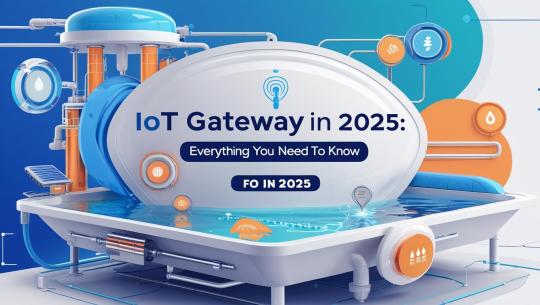
The world is becoming smarter every day. In homes, factories, farms, and cities, devices are talking to each other. This conversation, made possible by the Internet of Things (IoT), helps systems work faster and better. At the center of it all is one key technology the IoT gateway.
You might not notice it, but without an IoT gateway, most smart systems wouldn’t function smoothly. Whether you're using smart water meters, IoT device monitoring, or a smart irrigation system using IoT, this gateway plays a vital role. So, what exactly is an IoT gateway? Why does it matter more than ever in 2025? Let’s break it down in simple, real-world terms.
What Is an IoT Gateway?
An IoT gateway is a device that connects IoT sensors, devices, or machines with the internet or cloud platforms. It collects data from nearby devices, processes it, and then forwards it to a central system, often a cloud application. It also sends data back from the cloud to the devices when needed.
Imagine the IoT gateway as a translator, controller, and security guard rolled into one. It helps different devices “speak” the same language. At the same time, it controls the flow of data and protects it from threats. This is especially useful in sectors like agriculture, healthcare, utilities, and manufacturing.
Without this gateway, sensors and smart devices would struggle to work together or connect with external systems.
Why IoT Gateways Are Crucial in 2025
In 2025, data drives every decision. From managing water usage in homes to monitoring large industrial systems, real-time data plays a major role. With the rise of smart water management using IoT, the demand for reliable gateways has grown rapidly.
Here’s why IoT gateways are more important than ever this year:
1. Connecting the Unconnected
Most IoT devices use different communication protocols. Some may use Zigbee, while others rely on Bluetooth or Wi-Fi. The IoT gateway connects all of them to one unified system. This reduces confusion and keeps the network running smoothly.
2. Edge Processing Saves Time
Not every piece of data needs to be sent to the cloud. Gateways can process it locally, right at the edge. This saves time, reduces cloud costs, and allows for real-time decisions, something critical in IoT remote monitoring solutions.
3. Improved System Security
Data security is a growing concern. Hackers often target smart systems. Gateways protect data using firewalls, encryption, and secure login features. They act as the first line of defense in a connected world.
4. Reduced Latency for Faster Actions
Quick decisions are essential in systems like IoT device monitoring, where delays could lead to breakdowns or losses. Gateways process data locally, reducing delays and ensuring immediate responses.
5. Supports Scalable Networks
Whether you’re working with 10 or 10,000 devices, a good gateway can manage the traffic without breaking down. This makes it easier to expand your smart system over time.
How an IoT Gateway Works
Understanding how an IoT gateway works is easier if you compare it to a local traffic controller. Just like a controller routes cars at a junction, the gateway routes data from multiple sources.
Here’s a step-by-step look at what happens:
Data Collection: Sensors gather real-time information, such as temperature, humidity, water levels, or machine vibration.
Local Processing: The gateway checks and filters this data. It may convert formats so all devices can understand the information.
Data Encryption: Before sending anything, it secures the data to avoid unauthorized access.
Transmission: The useful data is then sent to the cloud for further analysis or storage.
Receiving Commands: If a system command comes from the cloud (like turning off a pump), the gateway delivers it back to the device.
This process takes just milliseconds but the result is a smarter, faster system.
Real-World Use Cases of IoT Gateways
IoT gateways are used across many industries today. Below are some common and powerful examples of how they make systems smarter and more reliable.
1. Smart Agriculture
In modern farming, growers use a smart irrigation system using IoT to optimize water use. Soil sensors measure moisture levels and send data to an IoT gateway. If the soil is too dry, the gateway activates the irrigation pump automatically. It helps save water and improve crop health.
2. Smart Water Management
Urban water systems rely on smart water meters to monitor consumption and detect leaks. These meters send data through gateways to the utility provider. The provider can track water usage and detect issues in real time, helping build a more efficient smart water management using IoT systems.
3. Industrial Equipment Monitoring
Factories run 24/7. With IoT device management, sensors on machines send performance data to a gateway. If a machine shows signs of overheating or failure, the gateway sends instant alerts. This helps prevent downtime and maintain productivity.
4. Remote Infrastructure Monitoring
Pipelines, dams, and remote power grids all use IoT remote monitoring solutions. In remote areas where cloud connection is weak, the gateway processes the data on-site. Only critical alerts are sent to the central office, saving time and bandwidth.
5. Smart Buildings and Homes
In smart buildings, gateways connect lighting, HVAC, fire alarms, and security systems. Building managers can control everything through a central system. With one dashboard, they can reduce power consumption, improve safety, and track occupancy levels.
Key Features to Look for in an IoT Gateway (2025 Version)
When selecting an IoT gateway, here are the must-have features in 2025:
Multi-Protocol Communication
It must support various protocols like Wi-Fi, LoRa, Bluetooth, Zigbee, and 5G for broader compatibility.
Real-Time Edge Analytics
Processing data at the edge saves time and supports fast action.
High Security
Gateways should have hardware-level encryption, secure boot, and regular firmware updates.
Remote Management Support
Users should be able to monitor and control gateways from anywhere.
Cloud Compatibility
The gateway must integrate smoothly with public and private cloud systems for backup, analytics, and updates.
Rugged Design for Harsh Environments
For outdoor or industrial use, the device should resist dust, water, and temperature changes.
Benefits of Using an IoT Gateway
The role of an IoT gateway extends beyond simple communication. Here are some of its top benefits in practical terms:
Better Performance: Real-time data processing leads to faster decisions.
Lower Costs: Only necessary data is sent to the cloud, reducing storage and data transfer charges.
Improved Safety: Gateways block unauthorized access and offer secure connections.
Scalability: Easily add more devices as your network grows.
Reliable Monitoring: Works perfectly for continuous systems like IoT device monitoring or utility tracking.
Smarter Operations: Gateways enable automation in systems like smart irrigation and smart water management.
Challenges in IoT Gateway Implementation
While they offer many benefits, deploying gateways also comes with challenges:
Power Management: Some gateways need constant power. In remote areas, solar or battery backup is essential.
Data Overload: Without proper filtering, too much data can slow down the network.
Security Risks: Older or poorly configured gateways can be a weak point for hackers.
Integration Issues: Matching the gateway with existing infrastructure can be tricky if the network is outdated.
Still, with the right planning and the right team, these issues are easy to manage.
The Future of IoT Gateways: Smarter, Faster, Safer
As we look ahead, the IoT gateway is expected to grow smarter and more autonomous. Future gateways will use AI to filter and predict trends before they happen. This predictive feature will be helpful in IoT remote monitoring solutions, where immediate action can prevent major failures.
Additionally, as smart water meters and IoT device monitoring become more common, new gateway models will support even more devices. With 5G, data speed will improve, and latency will fall even further. Moreover, power efficiency will be a priority. Expect to see solar-powered and battery-optimized gateways in rural and off-grid locations.
Final Thoughts
In 2025, the IoT gateway is no longer just a nice-to-have. It’s the engine that keeps smart systems running. Whether it's farming, city water management, factory monitoring, or building automation, gateways ensure devices communicate, protect data, and take smart action fast.
If you're planning a project with smart irrigation systems using IoT, smart water management using IoT, or any kind of IoT device monitoring, make the IoT gateway your top priority. With the right gateway in place, everything else falls into place smarter, faster, and safer.
0 notes
Text
Which Technology Is Best for eCommerce Website Development in 2025?

As eCommerce continues to evolve rapidly, choosing the right technology for your online store has become more important than ever. The digital landscape in 2025 is highly competitive, and businesses must rely on robust, scalable, and future-proof technologies to succeed. From the backend architecture to the user-facing interface, the right stack can define how your eCommerce business performs and grows over time.
Many businesses, especially in growing digital hubs like the UAE, are exploring advanced solutions to keep up with consumer demands. In this context, ecommerce website development Dubai services are focusing on newer frameworks, better integrations, and seamless user experience. These trends are shaping how technology is selected and implemented in the region and beyond.
Top Technologies for Building a Powerful eCommerce Website
There are several technologies available today that cater to different business models and project scopes. The key is to choose one that aligns with your long-term goals, expected traffic, and required features.
1. Headless Commerce This decoupled approach separates the frontend and backend, giving developers full freedom to design highly customized user interfaces. It's perfect for brands that want to deliver personalized, fast-loading, and mobile-first experiences across different channels—web, mobile apps, and even IoT devices.
2. Progressive Web Apps (PWAs) PWAs have gained popularity for their ability to function like native mobile apps while being delivered through web browsers. They offer offline capabilities, fast loading speeds, and push notifications, providing a seamless experience without requiring users to install an app.
3. API-First Platforms Many modern solutions are now built using an API-first architecture, allowing smoother integration with third-party services such as CRMs, ERPs, payment gateways, and logistics platforms. This flexibility makes it easier to scale and adapt as your business grows.
4. Open-Source vs SaaS Open-source platforms like Magento or WooCommerce offer complete control and customization, while SaaS platforms like Shopify offer faster deployment and ease of use. Businesses must evaluate which approach suits their budget, technical capacity, and customization needs.
Factors to Consider When Choosing Technology
Selecting the best eCommerce technology isn’t just about features—it’s about how well it fits your business model, target audience, and long-term plans.
1. Scalability Can the platform grow with your business? Make sure the technology you choose can handle increased traffic, product listings, and customer data as you expand.
2. Customization and Flexibility Every business is unique. Your technology stack should support tailored design, product filtering, checkout experiences, and more. Highly customizable solutions give you a competitive edge.
3. Security With growing cyber threats, eCommerce platforms must offer top-level security. Choose technologies that follow best practices for data encryption, payment security, and regular updates.
4. SEO and Performance Your store must be optimized for search engines and load quickly. Technologies that support clean URLs, fast page loading, and mobile responsiveness are essential for ranking and user retention.
Why Local Expertise Matters
Partnering with experts who understand the local digital environment can significantly impact your success. Daiyra 360 Communications – an Ecommerce Website Development Company in Dubai – specializes in creating tailored solutions that meet regional demands and global standards.
In a competitive landscape like the UAE, ecommerce website development Dubai trends are driven by innovation, user experience, and smart integration. Working with professionals who stay updated with the latest technologies ensures your website remains relevant and high-performing in the years to come.
#ecommercewebsitedevelopmentdubai#ecommercewebsitedevelopmentindubai#ecommercesolutionsdubai#ecommercedevelopmentdubai
1 note
·
View note
Text
Smart Plug for Personal Use Market: Growth Forecast and Industry Landscape 2025–2032
Smart Plug for Personal Use Market Emerging Trends, Technological Advancements, and Business Strategies 2025-2032
The global Smart Plug for Personal Use Market was valued at US$ 2.34 billion in 2024 and is projected to reach US$ 4.67 billion by 2032, at a CAGR of 9.01% during the forecast period 2025-2032
Our comprehensive Market report is ready with the latest trends, growth opportunities, and strategic analysis https://semiconductorinsight.com/download-sample-report/?product_id=42086
MARKET INSIGHTS
The global Smart Plug for Personal Use Market was valued at US$ 2.34 billion in 2024 and is projected to reach US$ 4.67 billion by 2032, at a CAGR of 9.01% during the forecast period 2025-2032. The market expansion reflects growing consumer demand for home automation solutions despite economic uncertainties from global events.
Smart plugs are IoT-enabled devices that connect to standard electrical outlets, allowing remote control of appliances via smartphone apps or voice assistants like Alexa and Google Assistant. These compact devices serve as gateways to smart home ecosystems, offering features like scheduling, energy monitoring, and compatibility with various smart platforms. While basic models provide simple on/off functionality, advanced versions incorporate energy tracking, surge protection, and multi-outlet configurations.
The market’s growth is primarily driven by rising smart home adoption, with North America leading at 38% market share in 2023. Key players including GE Lighting, Kasa, and Gosund dominate the landscape, collectively holding 45% revenue share. However, challenges like privacy concerns and compatibility issues continue to shape product development strategies as manufacturers balance innovation with consumer trust.
List of Key Smart Plug Manufacturers
GE Lighting (U.S.)
Kasa Smart (TP-Link) (China)
SmartPlug (U.S.)
Plug Smart (U.S.)
LifeSmart Inc. (China)
Humax (South Korea)
RonsElectronics Ltd (UK)
KMC (China)
Gosund (China)
Luceco Group (UK)
iHome (U.S.)
Segment Analysis:
By Type
Fixed Smart Plugs Hold Market Dominance Due to Stable Installation in Home Automation Systems
The market is segmented based on type into:
Fixed
Portable
By Application
Indoor Applications Lead Smart Plug Adoption for Home Energy Management and Convenience
The market is segmented based on application into:
Outdoor
Subtypes: Garden lighting, outdoor security devices, and others
Indoor
Subtypes: Kitchen appliances, entertainment systems, lighting, and others
By Connectivity
Wi-Fi Enabled Smart Plugs Remain Preferred Due to Seamless Integration with Smart Home Ecosystems
The market is segmented based on connectivity technology into:
Wi-Fi
Bluetooth
Zigbee
Others
By Distribution Channel
E-Commerce Platforms Show Accelerated Growth as Online Retail Expands Globally
The market is segmented based on distribution channels into:
Online
Subtypes: Company websites, e-marketplaces, and others
Offline
Subtypes: Specialty stores, hypermarkets, and others
Regional Analysis: Smart Plug for Personal Use Market
North America The North American smart plug market is the most advanced globally, driven by high smartphone penetration, widespread smart home adoption, and strong consumer demand for energy-efficient solutions. The U.S. dominates the region, accounting for over 80% of regional revenue due to its well-established smart home ecosystem and the popularity of voice assistants like Amazon Alexa and Google Assistant. Canada also shows steady growth, particularly in urban areas where smart home automation is gaining traction. However, concerns about data security and privacy remain a key challenge, leading to stricter regulations around IoT device standards. Major players like GE Lighting and Kasa leverage advanced energy monitoring features to appeal to cost-conscious consumers amidst rising electricity prices.
Europe Europe’s smart plug market benefits from robust environmental policies pushing energy conservation and home automation. Germany and the UK lead adoption, supported by high disposable incomes and rapid tech integration in households. The EU’s focus on reducing carbon emissions has accelerated demand for smart plugs with real-time energy tracking, particularly in countries like France and the Netherlands. Despite this growth, compatibility issues between regional voltage standards (e.g., 220-240V) and international smart plug models create fragmentation. Local brands like Luceco Group have gained prominence by addressing regional needs, while price sensitivity in Southern Europe limits market penetration of premium products.
Asia-Pacific Asia-Pacific is the fastest-growing market, fueled by expanding middle-class populations and government smart city initiatives in China, Japan, and South Korea. China alone contributes over 45% of regional sales due to aggressive pricing strategies by domestic brands like Gosund and Xiaomi. India shows strong potential with increasing smartphone and broadband access, though low awareness in rural areas remains a barrier. Portable smart plugs dominate the region due to their versatility, while outdoor variants gain traction in Australia and Singapore for garden and patio use. Intense competition has led to thinner profit margins, pushing manufacturers to innovate with features like surge protection and multi-socket designs.
South America The South American market remains nascent but shows promise in Brazil and Argentina, where urban consumers are adopting entry-level smart plugs for basic appliance control. Economic instability and currency fluctuations, however, restrict access to imported brands, creating opportunities for local manufacturers offering budget-friendly options. Smart plug usage is largely concentrated in major cities, with indoor applications like lighting and small appliances being primary use cases. Limited smart home infrastructure and intermittent internet connectivity in some areas slow broader adoption, though younger demographics demonstrate growing interest in home automation technologies.
Middle East & Africa This region presents a mixed landscape, with Gulf Cooperation Council (GCC) countries like the UAE and Saudi Arabia driving demand through luxury smart home installations. High disposable incomes and government investments in smart infrastructure support premium smart plug adoption, particularly for air conditioning and entertainment systems control. In contrast, African markets face challenges like inconsistent electricity supply and low consumer awareness, though South Africa and Nigeria show gradual uptake among tech-savvy urban populations. The lack of standardized regulations across the region complicates market entry for international brands, while security concerns deter some consumers from adopting connected devices.
MARKET DYNAMICS
As internet penetration exceeds 60% in many developing countries and smartphone ownership continues to rise, significant growth opportunities exist for smart plug manufacturers to expand into emerging markets. Companies are developing cost-optimized smart plug models specifically designed for these regions, featuring offline functionality and robust designs to accommodate inconsistent power conditions. Local partnerships with telecom providers and e-commerce platforms are helping manufacturers establish distribution channels and educate consumers about the benefits of smart home technologies.
The global shift toward renewable energy presents new opportunities for smart plug innovation. Advanced models now offer features that optimize appliance usage based on solar generation patterns or off-peak grid tariff periods. Some next-generation smart plugs can interface with home battery storage systems, automatically shifting appliance operation to periods of maximum solar production or lowest electricity costs. As residential solar installations continue to grow at an annual rate of over 20% in many markets, the demand for energy management-enabled smart plugs is expected to rise correspondingly.
The healthcare sector represents an increasingly important opportunity for smart plug manufacturers. Smart plugs integrated with remote monitoring capabilities are being adopted in assisted living facilities and private homes to help caregivers track medication schedules and appliance usage patterns among elderly patients. The ability to receive alerts when critical devices like medical equipment are turned off unexpectedly adds an important safety layer for vulnerable populations. Partnerships with healthcare providers and insurance companies are helping drive adoption of these specialized smart plug solutions.
Smart plug manufacturers face growing competition from appliances with built-in smart capabilities, reducing the need for standalone smart plugs. Many modern televisions, air conditioners, and kitchen appliances now include Wi-Fi connectivity and remote control features, potentially making smart plugs redundant for these applications. Additionally, the popularity of smart lighting systems threatens to cannibalize one of the primary use cases for smart plugs in residential settings. This market dynamic forces smart plug vendors to continuously innovate and demonstrate unique value propositions beyond basic remote control functionality.
With hundreds of smart plug models available globally, manufacturers struggle to differentiate their offerings in an increasingly commoditized market. Many products now offer similar core features, making it difficult for companies to command premium pricing or build brand loyalty. This challenge is exacerbated by private label products from major retailers and the growing presence of low-cost manufacturers, particularly from Asia. Smart plug vendors must invest in specialized features, superior reliability, or unique ecosystem integrations to maintain competitive advantage in this environment.
Smart plug manufacturers must navigate an increasingly complex regulatory landscape that varies significantly by region. Obtaining necessary safety certifications like UL, CE, or FCC adds substantial time and cost to product development cycles. Recent regulatory changes in some markets now require additional cybersecurity certifications for IoT devices, further increasing compliance burdens. These regulatory challenges are particularly difficult for smaller manufacturers to navigate, potentially limiting innovation and competitive diversity in the smart plug market.
The market is highly fragmented, with a mix of global and regional players competing for market share. To Learn More About the Global Trends Impacting the Future of Top 10 Companies https://semiconductorinsight.com/download-sample-report/?product_id=42086
FREQUENTLY ASKED QUESTIONS:
What is the current market size of Global Smart Plug for Personal Use Market?
Which key companies operate in this market?
What are the key growth drivers?
Which region dominates the market?
What are the emerging trends?
CONTACT US: City vista, 203A, Fountain Road, Ashoka Nagar, Kharadi, Pune, Maharashtra 411014 [+91 8087992013] [email protected]
0 notes
Text
United States LED Light Emitting Diode (LED) Market Size Brightening the Future of Illumination
The United States LED Light Emitting Diode Market is undergoing significant transformation, driven by growing energy efficiency goals, government initiatives, and technological advancements. LEDs have become the go-to lighting solution for residential, commercial, industrial, and automotive applications, thanks to their superior energy savings, durability, and environmentally friendly nature.
Market Overview
The rapid adoption of LED lighting in the U.S. is aligned with national policies aimed at reducing carbon emissions and lowering energy consumption. LED lights consume up to 80% less energy than traditional incandescent bulbs and have a longer operational life, making them an ideal solution in today’s sustainability-driven market.
Federal and state-level energy efficiency programs, including rebate schemes and phase-outs of inefficient lighting technologies, have significantly boosted LED demand. Additionally, the smart lighting trend and integration with IoT (Internet of Things) systems have further enhanced the functionality and appeal of LED products across various sectors.
Market Segmentation
By Product Type:
LED Bulbs & Lamps
LED Fixtures
LED Modules
Others
By Application:
Residential
Commercial
Industrial
Automotive
Horticulture
Street Lighting
By Installation Type:
Retrofit
New Installation
By Region:
Northeast
Midwest
South
West
Key Market Trends
1. Smart LED Lighting Systems
The shift toward smart homes and buildings has led to increasing adoption of LEDs integrated with sensors, dimming features, color temperature controls, and app-based management.
2. Government and Regulatory Push
Incentives from organizations such as the U.S. Department of Energy (DOE) and the Environmental Protection Agency (EPA) continue to drive LED adoption through programs like ENERGY STAR.
3. Expansion in Outdoor & Street Lighting
Municipal infrastructure upgrades are fueling the demand for durable, long-life LED street lights with smart controls for energy monitoring and adaptive brightness.
4. Surge in Automotive LED Use
Automotive lighting is experiencing a revolution, with LEDs being used for headlights, taillights, indicators, and interior lighting due to their compact size, brightness, and energy efficiency.
5. Focus on Sustainable Manufacturing
Leading manufacturers are incorporating recycled materials and greener production processes to reduce the environmental impact of LED manufacturing.
Competitive Landscape
Top players dominating the U.S. LED market include:
Cree LED
Signify (Philips Lighting)
GE Lighting (a Savant company)
Acuity Brands
Eaton (Cooper Lighting)
Osram Sylvania
Hubbell Lighting
Samsung Electronics
Nichia Corporation
These companies focus on innovation in light quality, smart features, connectivity, and modular designs to cater to evolving consumer needs.
Trending Report Highlights
Explore the latest technological innovations across electronics and energy efficiency:
Weather Simulation Chamber Market
High Pass Filters Market
Robot Tool Changers Market
Wi-Fi Gateway Market
Wind Turbine Sensor Market
Digital Movie Camera Market
Low Power Next Generation Display Market
Machine Sensor Market
Memristor Market
Network Packet Broker Market
Precision Resistor Market
Thermocouples High End Optical Pyrometer Market
Green Laser Diode Market
0 notes
Text
Future-Proofing Innovation: How Custom iOS App Development Empowers Unique Business Ideas

Introduction: Why One-Size-Fits-All Doesn’t Work Anymore
In a world where innovation defines success, businesses with unique ideas can’t rely on off-the-shelf mobile solutions. iOS, known for its security, performance, and loyal user base, offers an exceptional foundation—but real power lies in custom iOS development. It’s not just about having an app—it’s about building an experience that aligns with your distinct vision and evolves with the future.
1. What is Custom iOS App Development?
Custom iOS app development is the process of designing and building tailor-made apps for Apple devices—iPhone, iPad, and more—specifically crafted to solve unique business problems or serve niche customer needs. This approach goes beyond basic templates, ensuring the app is fully aligned with brand identity, user behavior, and operational goals.
2. Why Unique Business Ideas Need Custom Solutions
Every innovative idea comes with unique workflows, user journeys, and expectations. Custom iOS development lets you:
Differentiate in a crowded marketplace
Build IP (Intellectual Property) around your idea
Offer niche functionality that no off-the-shelf app can provide
Evolve the product roadmap over time based on user feedback
Whether you’re building a fitness app for a specific demographic or creating an on-demand service for rural areas, customization is key to success.
3. Making Your App Future-Ready: Key Strategies
A future-ready app is not just about today’s features. It must scale, adapt, and innovate as user expectations and technologies evolve. Here’s how custom iOS development helps:
a. Scalability
Built with growth in mind, custom apps can handle increasing traffic, data, and feature updates smoothly.
b. Integration-Ready
Custom apps can integrate seamlessly with third-party tools, IoT devices, payment systems, or even enterprise software like Salesforce or SAP.
c. Use of Latest Apple Features
Stay ahead by integrating the latest Apple frameworks—ARKit, SwiftUI, SiriKit, and more.
d. Data Security & Privacy
With Apple’s strong privacy guidelines, a custom app can implement advanced security standards to protect sensitive data—crucial for industries like healthcare and finance.
4. Industries Driving Innovation with Custom iOS Apps
Custom iOS solutions are transforming several industries:
Healthcare – Telehealth, appointment booking, patient monitoring
Fintech – Secure payment gateways, portfolio tracking, crypto integration
Retail & eCommerce – Personalized shopping, AR try-ons, smart loyalty programs
Education – LMS platforms, remote classrooms, interactive learning tools
Logistics – Real-time tracking, smart routing, supply chain visibility
5. Choosing the Right iOS Development Partner
Future-ready apps require more than coding skills. Look for a development partner who:
Understands your industry and user personas
Offers strategic consultation—not just technical delivery
Designs with UX and UI best practices
Builds with future scalability in mind
Provides post-launch support and version upgrades
Conclusion: Start Building for Tomorrow, Today
Innovation doesn’t wait. If your business idea is bold, niche, or groundbreaking, it deserves a solution built just for it. Custom iOS mobile app development is the bridge between your unique vision and a high-performance, future-ready mobile experience. Don’t settle for generic—build something that truly belongs to you.
#app development company in California#mobile app development company in California#app development company California#mobile app developer in California#app developer in California#app development company in texas#mobile app development company in texas#app development company texas#mobile app developer in texas#app developer in texas
0 notes